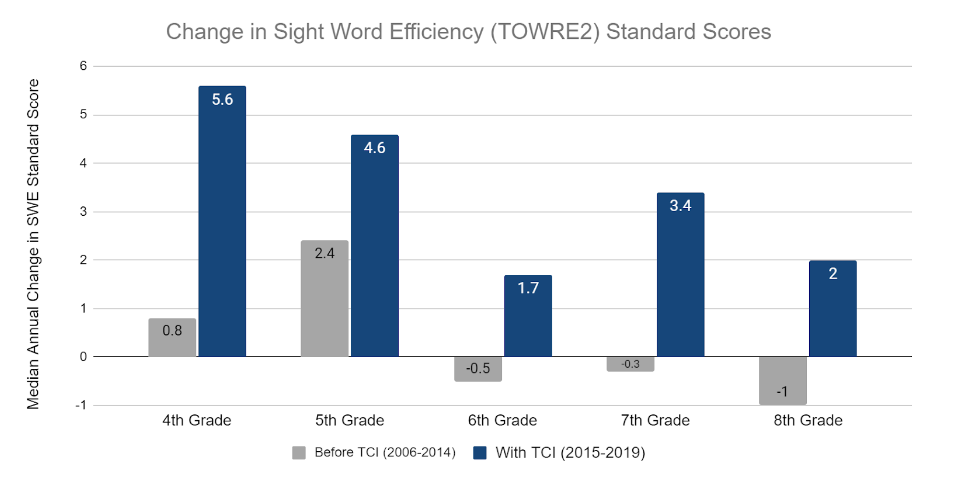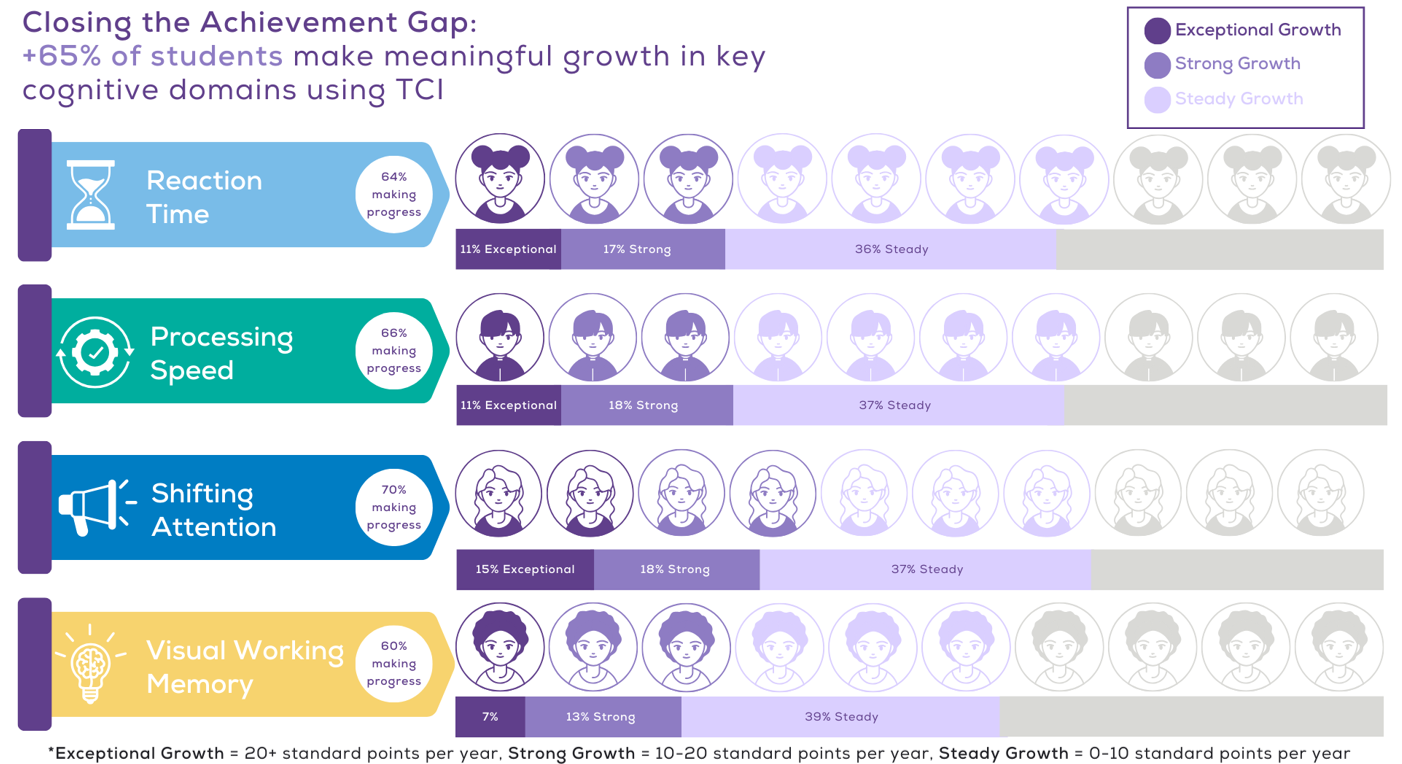Closing The Gap With Typical Learners
November, 2023
TCI Improves Oral Reading Fluency, Closing the Gap With Typical Learners
Our latest data demonstrates a statistical relationship between improvements in TCI and improvements in Oral Reading Fluency.
Key Findings
TCI improves Oral Reading Fluency, helping students close the gap with typical learners
There is a positive correlation between cognitive skills and oral reading fluency
We can intervene to help students make more than expected growth in these skills
Since incorporating TCI into the curriculum, 61% of Carroll students have made expected or faster than expected annual progress in oral reading fluency, closing the gap with typical learners.
The percentage of students making expected and faster than expected growth in oral fluency is largest among students with the most significant vulnerabilities in oral reading fluency:
70% of students who started the school year with a weakness in oral reading fluency (below the 25th percentile) are making expected or faster than expected annual progress
76% of students who started the school year with a significant weakness in oral reading fluency (below the 10th percentile) are making expected or faster than expected annual progress.
Expected progress is defined as a student keeping pace within the same percentile. Faster than expected progress means that students are crossing those percentile bands. For example going from the 10th to 11th percentile, or going from the 25th the 30th percentile. In this population 100% of students have a diagnosed language-based learning difficulty and a history of reading difficulties. The typical outcome for students with language-based learning difficulties, dyslexia, and/or a history of reading difficulties is that they fall further behind each year. The fact that they are closing the achievement gap with typical learners is truly remarkable.
Figure 1 - Annual Oral Reading Fluency Growth as measured by Read Naturally Benchmark Assessor (Hasbrouk & Tindal, 2006; Hasbrouk & Tindal 2017)
When we compare annual growth in sight word efficiency before TCI was added to Carroll’s curriculum vs after we see that there’s a significant improvement in the mean annual change using the TOWRE2. Sight word efficiency growth has more than doubled since introducing TCI. The chart below breaks out the mean annual change by grade.
Figure 2 - Change in Sight Word Efficiency (TOWRE2) Standard Scores
How does TCI improve oral reading fluency?
TCI strengthens cognitive skills that are required for developing reading fluency. It strengthens the reading network in the brain, creating cognitive capacity that allows students to more easily access structured literacy instruction (Orton-Gillingham). By building capacity students are able to make meaningful and significant growth in oral reading fluency, closing the gap with typical learners.
Our data shows a statically significant positive correlations between oral reading fluency and the cognitive skills targeted in TCI. Those include:
Reaction Time*
Reaction Time + Inhibition**
Processing Speed*
Symbol Digit Coding Correct Responses**
Shifting Attention Correct Responses*
Simple Visual Working Memory**
* indicates a statistically significant correlation (p<0.05); ** indicates a highly statistically significant correlation (p<0.01)
As these cognitive skills grow, oral reading fluency improves. In fact, the more the skills grow the more oral reading fluency improves. TCI helps students make meaningful progress in the cognitive skills that correlate with oral reading fluency. Looking at Carroll students who participated in TCI between 2013-2023 we see that:
64% made annual progress in Reaction Time beyond what is predicted by the norms
66% made annual progress in Processing Speed beyond what is predicted by the norms
70% made annual progress in Shifting Attention beyond what is predicted by the norms
60% made annual progress in Visual Working Memory beyond what is predicted by the norms
Cognitive development happens without cognitive intervention. A certain amount of growth is standard. This is accounted for in the norms used in TCI’s cognitive assessment battery. These students are making growth beyond normal cognitive development.
Figure 3 - Change in Cognitive Domains with TCI
Why does oral reading fluency matter?
Fluency is an important part of reading. To become a proficient reader students need to be automatic with text so that they can focus on the comprehension. Students struggling with oral reading fluency will struggle to keep up with grade-level reading expectations for typical readers. They will struggle to read efficiently, spending more time decoding individual words rather than being able to focus on the meaning of the text. So why does oral reading fluency matter? It matters because oral reading fluency makes reading easier. It’s the bridge between word recognition and comprehension. It enables:
Reading for understanding
Reading to learn
Accessing content across all subject areas in school


